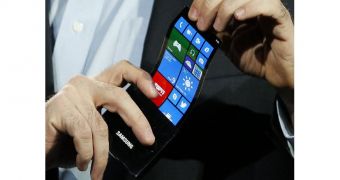At least a few major handset makers conduct in-house projects that involve curved displays or curved batteries, which are the most important parts of the so-called “curved smartphone.”
LG and Samsung have been showing these technologies for the last couple of years at various trade fairs, such as Mobile World Congress (MWC) and IFA, but all devices were in prototype stage and as much as these companies wanted to assure the media they are close to offering a mass market product this did not happen until late last year.
Why would anyone want to carry a curved smartphone? Is there any advantage over the standard handsets or people would just buy one to show off?
Let's take world's first curved smartphone, the Samsung Galaxy Round which was launched late last year in South Korea. Well, it appears that Samsung's main reason for launching the Galaxy Round was to test the market and see if there is really demand for such devices.
However, the smartphone was only available in South Korea and Samsung confirmed it won't release the Galaxy Round in other countries, probably due to low components that such a phone would require.
The second smartphone that made it to market and feature more than a curved display is the LG G Flex. This was the second device ever launched on the marker that can be tagged as a “curved smartphone,” but the first destined for mass market.
LG G Flex has been launched in a dozen countries back in February, but it's too early to tell how many units LG shipped during this time.
It appears that only LG was in fact interested in learning if there's a market for this type of devices, as Samsung only launched its Galaxy Round in South Korea.
Each of the two companies, LG and Samsung, pitched its smartphones to potential customers with different advantages, but what about the practicality of such a device.
Samsung Galaxy Round and LG G Flex smartphones were powerful in terms of hardware, so this was not a problem. Even though these devices are curved only the LG G Flex is slightly flexible. Even so, there's no real use for such a feature.
Both companies claim legibility in strong sunlight is much better on a curved display, but our tests during LG G Flex review proved that this is barely noticeable. Then there's a ergonomics that LG likes to brag about so much.
Due to the fact that LG G Flex is curved from up to bottom, it molds better on once face shape when the phone is kept on the ear. This is indeed an advantage, but I'm not sure that can be tagged as a major selling point for the device.
My point is that curved smartphones would have a broader market if handset manufacturers would offer real advantages as opposed to standard phones.
For the time being, aside from having a powerful smartphone with a curved display that reads nicely when in landscape mode, there's no real advantage of owning one.
The curved display technology is in its incipient state, but I have full confidence that as soon as more companies continue to invest in innovation, we will soon have real flexible smartphones, or even foldable ones.

 14 DAY TRIAL //
14 DAY TRIAL //